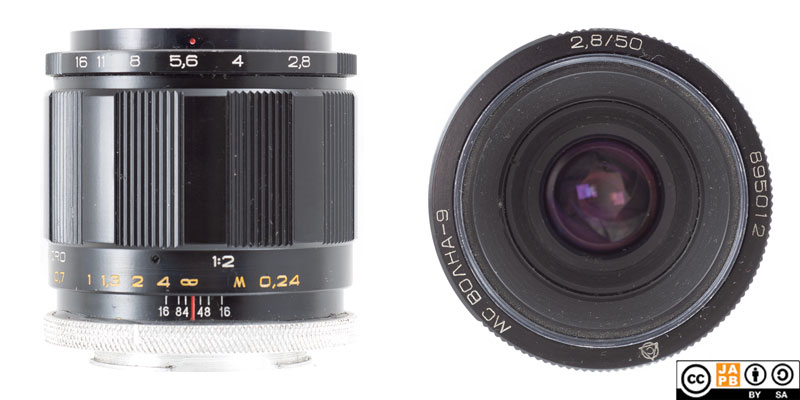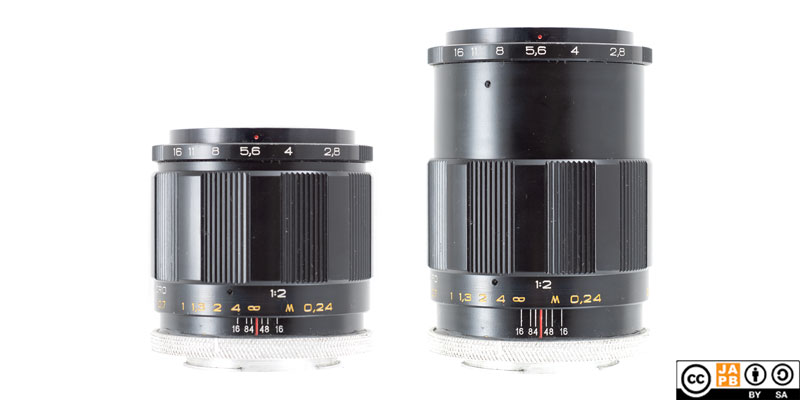Pekka Buttler, 03/2025

Specifications
The table below summarizes the lens’ key specifications (measurements based on pictured lens):
| Brand: | Volna/Волна | Lens name | 9 2.8/50 (MC) |
| Focal length(s) 1 | 50 mm | Angle-of-view 2 | 46 ° (on ‘full frame’) |
| Maximum Aperture | f/2.8 | In Production | 1984–19913 |
| Lens mount (this lens] | Nikon F | Lens mount (normally) | M42 |
| Length 4 | 63,6 mm | Diameter 5 | 64,4 mm |
| Filter ring diameter | 52 mm | Weight | 331 grams |
| Lens element count | 6 6 | Lens group count | 5 |
| Aperture blades | 6 7 | Focus throw | 345 ° |
| Minimum focusing distance (indicated/measured) | 23,8/23,2 cm | Maximum magnification (indicated/measured) | 1:2 / 1:1,95 |
| Has manual aperture ring | YES | Has Manual focus ring | YES |
| Aperture mechanism type | Preset | Aperture click stops | None. Preset ring at full stops. |
Further notes:
• The Volna/Волна-9 is a 1980s Soviet short macro lens. Alike most macro lenses of its era, it does not reach 1:1 magnification without the use of extension rings.
• The Volna/Волна-9 was serially produced only for the M42 mount. There seems to have been a prototype/experimental batch of lenses made for the Pentax K mount, but these are extremely rare.
• The Nikon F mount on this lens seems to have been an aftermarket modification, likely to serve the interests of a Kiev 17/19 user8. The modification is quite frankly on the rough side, and my sample does not quite reach infinity focus. On the flipside, its maximum magnification is a tad better than it’s supposed to be.
• The Volna-9 is at times (especially on eBay and other online marketplaces) referred to as a “Tessar copy” which is utter *rap. The Tessar was a 4 elements in 3 groups design (the Volna-9 is a 4/4 design).

Right: Volna-9 focused at minimum focusing distance.
• All Volna-9 lenses were manufactured at LZOS/Lytkarino plant.
• The Volna-name does not refer to a brand, design bureau or indeed a factory. Instead, the name Volna (which means ‘wave’) indicates that it is a member of a late-soviet-era family of standard focal length lenses. See more in the JAPB articles on Soviet lenses and the Soviet lens ‘business’
Versions
Notwithstanding the prototype copies manufactured for the Pentax K mount, all 50+ samples of the Volna-9 I have seen follow the exactly same design. There seems to have been some variation in the exact hue of the focus ring’s yellow/orange/ochre markings, but otherwise no changes seem to have been made to the design over the shortish production period.
Adapting
Assuming that your copy has the original M42 mount:
If you want to natively mount this lens you need to find a functioning M42 mount film camera. Luckily that should be relatively easy as M42 bodies were produced in their millions and most of them lack features that are especially likely to have deteriorated to the point of making the entire camera inoperable.
Adapting this lens to a mirrorless, full-frame digital camera is a breeze thanks to the lens having full manual controls (aperture ring, focus ring). You simply need a dumb adapter from M42 to your mirrorless system (And set the lens in manual mode to be sure the aperture works as you intend).
Due to the medium flange focal distance used by the m42 mount (45,46 mm), whether you can adapt this lens to dSLR/SLR mounts depends on which dSLR mount: Canon EF, Four Thirds, Minolta/Sony A and Pentax K can mount M42 lenses using a simple adapter ring. Nikon F on the other hand is not as problem-free, and – to retain anything near infinity focus – the adapter will necessitate corrective optics. In all cases, your camera will work only in stop-down metering.
Footnotes
- Focal length is (unless stated otherwise) given in absolute terms, and not in Full-frame equivalent. For an understanding of whether the lens is wide/tele, see ‘Angle-of-view’. ↩︎
- Picture angle is given in degrees (based on manufacturers’ specs) and concerns the diagonal picture angle. Rule of thumb:
> 90 ° ==> Ultra-wide-angle
70–90 ° ==> Wide-angle
50–70 ° ==> Moderate wide-angle
40–50 ° ==> ‘Standard’ or ‘normal’ lens
20–40 ° ==> Short tele lens
10-20 ° ==> Tele lens
5-10 ° ==> Long tele lens
< 5 ° ==> Ultra-tele lens ↩︎ - Serial production is reputed to have begun in 1984. Based on serial numbers of documented lenses, manufacture dropped sharply after 1990 and latest samples have serial numbers indicating manufacture in 1991. ↩︎
- Length is given from the mount flange to the front of lens at infinity. ↩︎
- Diameter excludes protrusions such as rabbit ears or stop-down levers. ↩︎
- An earlier version of this data sheet gave the lens’ design as 4 elements in 4 groups. Thanks to a keen-eyed reader (see comments), this information turned out to be questionable and has now been corrected. ↩︎
- The Aperture blades take the shape of a circular saw blade from f/3-5–f4, a star from f/5.6 to f/8 and a hexagon from f/11 to f/16 ↩︎
- The Kiev 17/19 is series of Soviet SLRs that used the Nikon F mount. Read more here. ↩︎
It’s not a 4/4 lens, it’s a 6/5 lens. This page:
https://fotoussr.ru/lenses/volna-9/
has optical schematics.
Thank you for this resource. Interestingly, another source (https://www.photohistory.ru/1283775402508044.html) clearly says 4/4.
Huh, that’s strange because this resource is really well-curated and respected. I am not sure if it’s just a typo or due to the fact that lens groups on Volna-9 are set in 4 “supergroups” which can lead to some confusion; so unless I am completely delusional (or there’s another version of the lens that I am not aware of), I think it must be an error on their website. I’ll write them about it to investigate further.
Here’s a link to the video with (almost) complete lens disassembly:
https://youtu.be/4hZ_qd9yxmg?si=ji_c1Sjof-fKsHUG
The optical group disassembly starts at 20:28. Lens groups themselves were not taken apart, but it can be clearly seen that there were 5 lens groups.